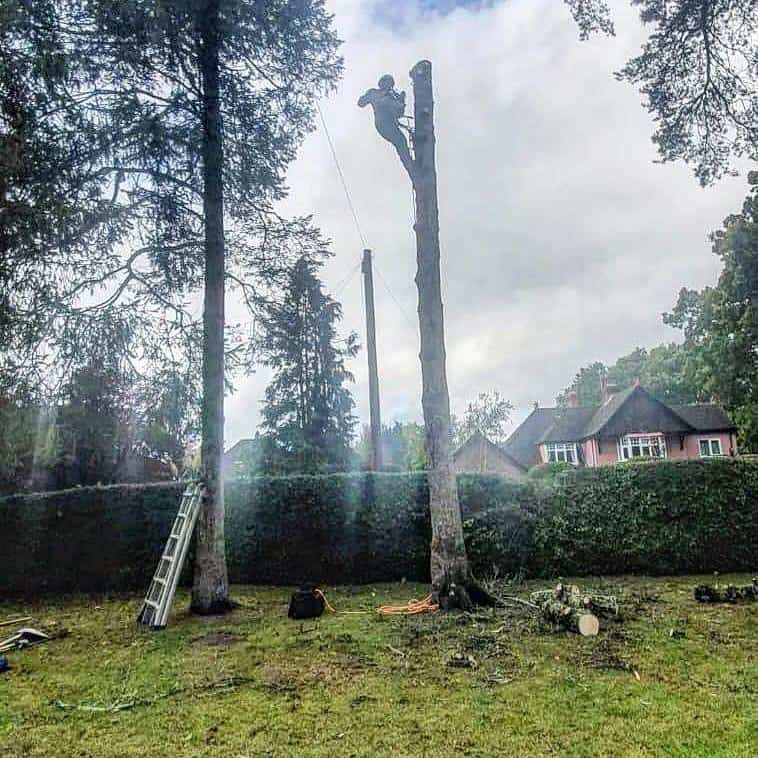A leaning tree can often be a striking feature in a garden, adding character and natural beauty. However, when that lean becomes excessive or develops suddenly, it can be a serious cause for concern. A tree that leans too far can pose a significant risk to property, people, and surrounding vegetation. Understanding when a leaning tree has become dangerous — and when removal is the safest option — is essential for responsible tree management. At LM Tree Surgery Haslemere in Haslemere, Surrey, we help homeowners assess and deal with leaning trees safely and professionally.
Why Trees Lean
It’s perfectly normal for some trees to lean slightly. A gentle angle may occur due to natural light-seeking growth (phototropism), consistent wind direction, or root adaptation to uneven soil. However, not all leans are harmless.
There are two main types of tree lean:
- Gradual lean – develops over many years and is often stable, with the tree’s roots adapting to the position.
- Sudden lean – occurs quickly, often after storms, high winds, or soil movement, and is a strong indicator of structural instability.
A sudden change in angle or a rapidly increasing lean should never be ignored, as it often signals a compromised root system or internal weakness.
The Dangers of an Unstable Leaning Tree
When a tree leans excessively, it shifts its centre of gravity, putting immense pressure on one side of the root system and trunk. This imbalance can lead to several hazards:
1. Risk of Collapse
If roots have lifted, snapped, or loosened due to soil erosion or decay, the tree may no longer be anchored securely. Even a moderate gust of wind can cause it to fall unexpectedly.
2. Structural Damage
Leaning trees that grow near houses, fences, driveways, or roads can cause significant damage if they fall. Large branches may also snap off as the tree struggles to bear its own weight.
3. Root Failure
A major cause of dangerous leaning is root failure, often triggered by over-saturated soil, construction near the root zone, or fungal decay. Once roots lose their hold, the tree’s stability declines rapidly.
4. Safety Hazards
A leaning tree poses a serious risk to anyone nearby — whether it’s residents, pedestrians, or vehicles. When the degree of lean becomes unpredictable, removal may be the only safe solution.
How to Tell When a Leaning Tree Is Unsafe
Not every leaning tree needs to come down, but certain warning signs indicate that the lean may have reached a dangerous level.
Key warning signs include:
- A sudden change in the angle of the lean.
- Cracked or heaving soil on the side opposite the lean, showing root movement.
- Exposed or broken roots near the base.
- A split or crack in the trunk at the base or along the leaning side.
- New gaps in the ground near the tree, especially after heavy rain or wind.
- Branches rubbing against buildings or overhanging heavily trafficked areas.
If any of these symptoms are visible, it’s important to have the tree inspected immediately by a professional arborist such as LM Tree Surgery Haslemere. Early assessment can determine whether corrective work can stabilise the tree or whether removal is necessary.
Common Causes of Dangerous Tree Lean
Several factors can contribute to a tree developing a dangerous lean, particularly in areas with variable weather and soil conditions like Haslemere, Surrey.
1. High Winds and Storms
Strong winds can weaken the structural integrity of a tree, especially those with shallow roots or saturated soil. Once a tree begins to tilt, subsequent weather events can worsen the problem.
2. Poor Root Anchorage
Compacted soil, restricted growing space, or recent landscaping work near the base of the tree can damage or weaken the roots. Without proper anchorage, the tree loses its ability to remain upright.
3. Soil Erosion or Instability
Sloped gardens or properties with poor drainage can suffer from soil erosion, gradually undermining a tree’s root system. Trees on embankments are particularly vulnerable.
4. Internal Decay
Hidden decay within the trunk or root collar often goes unnoticed until the tree begins to lean dramatically. Fungal growth or hollow cavities at the base are common indicators of advanced decay.
5. Uneven Canopy Weight
If a tree grows toward one side due to light competition or previous improper pruning, it can create an unbalanced canopy. This uneven weight distribution increases the lean over time.
When a Tree Must Be Removed
While some leaning trees can be saved through corrective pruning, bracing, or cabling, others present too much risk to remain standing. Removal becomes the safest option when:
- The lean has increased rapidly within a short period.
- Roots are visibly lifting or damaged.
- The trunk shows signs of splitting or decay.
- The tree leans toward a building, path, or public area.
- The soil around the base has shifted or cracked significantly.
In such cases, delaying removal can lead to serious damage or injury. Professional assessment ensures that the correct action is taken before failure occurs.
The Role of Professional Tree Surgeons
Identifying whether a leaning tree is safe or not requires expertise and experience. At LM Tree Surgery Haslemere, we assess each case carefully using a combination of visual inspection and advanced diagnostic techniques to determine the tree’s stability.
Our team considers factors such as:
- The degree and direction of the lean.
- The tree’s age, species, and root structure.
- Recent weather events and ground conditions.
- Signs of decay, pest damage, or disease.
Based on the assessment, we provide tailored recommendations — from corrective pruning and support systems to complete removal when necessary. Our goal is always to balance safety with preservation, keeping your property secure while protecting the surrounding environment.
Preventing Future Leaning Problems
Regular tree maintenance plays a key role in preventing dangerous leaning. Some preventive steps include:
- Routine pruning to manage canopy weight evenly.
- Monitoring root zones for compaction, excavation, or waterlogging.
- Early inspections after storms or high winds.
- Maintaining soil health to encourage deep, strong root development.
Proactive care not only prevents dangerous leans but also promotes stronger, healthier trees that enhance your garden for years to come.
Why Homeowners in Haslemere Choose LM Tree Surgery Haslemere
LM Tree Surgery Haslemere provides expert, safe, and efficient solutions for dealing with leaning trees and other structural tree concerns. Serving homeowners across Haslemere and the wider Surrey area, we combine experience with professional care to ensure that trees are managed responsibly and with precision.
Whether your tree needs corrective pruning or full removal, our qualified team ensures every job is carried out to the highest standard, safeguarding your property and maintaining the natural beauty of your landscape.
Conclusion
A slight lean in a tree can be perfectly natural, but when the tilt becomes pronounced or begins to worsen, it’s a clear sign that action may be needed. Ignoring the issue can lead to sudden failure and potentially serious damage. Regular inspections and prompt intervention are key to maintaining safety. For expert assessment and professional advice, homeowners can rely on LM Tree Surgery Haslemere in Haslemere, Surrey, to determine when a leaning tree must come down — and to handle the situation safely, efficiently, and with care.
Call us on: 01428 770 497
Click here to find out more about LM Tree Surgery Haslemere
Click here to complete our contact form and see how we can help with your tree needs.

